TIFFANY & Co. Ring
My Beloved Kobe City / Christmas
December 23 is the Birthday of Emperor, one of Japanese national holidays, so I took a stroll around Kobe city. Christmas is just around the corner, so I intended to present my fiancee with a ring. Christmas in Japan is, if anything, a day for couples, while it in other countries is one for a family.
Unfortunately, even though it was a rainy day on December 23, but Kobe city was so crowded. I could feel a Christmas atmosphere through Kobe city, and I felt cheerful. My beloved Kobe is famous as a fashionable and sophisticated city. Among the people in Tokyo, the Kobe city is recognized as a fashionable city. Among the Kansai region, Kobe city also shows a unique presence, although there are many cities in the region which have unique cultures, such as Kyoto and Osaka. That’s what I love about and take pride in Kobe city.
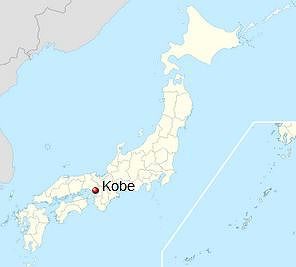
Kobe City
Daimaru Kobe Department Store
There are two large department stores, Sogo and Daimaru in Kobe city. Sogo is located near the Sannomiya station and Daimaru is located near the Motomachi station. The people in Kobe city often visit both.

Kobe Sogo Department Store
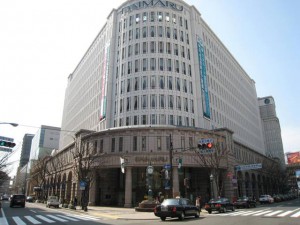
Motomachi Daimaru Department Store
I visited the Daimaru department store today. Departments stores are very convenient because we can see different types of rings at many shops. Cartier, BVLGARI, CHANEL, Tiffany & Co., Van Cleef & Arpels, CHAUMET, Harry Winston―the floor was filled with many well-known luxury brand stores. I was really exhausted because we carefully saw so many rings. Shopping requires a lot of work, I think.
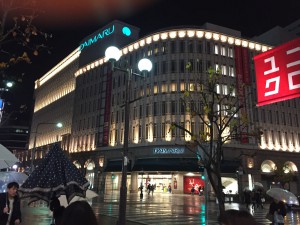
Daimaru Department Store
Break Time at CAFFERA
After we looked over most rings, we had a break at the CAFFERA cafe, to organize our thoughts. CAFFERA cafe is popular because we can relax at the terrace while looking at Kobe’s streets which are lined with many shops. We had two cappuccino and relaxed. We held a meeting to select a ring, feeling much better by the latte art.
Tiffany & Co.’s Ring / My Christmas Present
My fiancee eventually was pleased with Tiffany & Co.’s ring, and I bought it as a Christmas present. She was pleased that a pinkish-gold ring suited her skin color, and gave a warm impression.
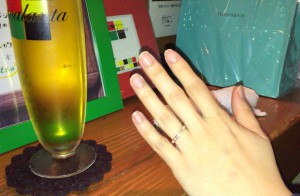
TIFFANY & Co. Ring / My Christmas Present
Art Gallery
We finished choosing the appealing ring, and also went to an art gallery on the 7th floor on the way. There are usually art galleries in Japanese department stores like this, and many events are held throughout a year. We couldn’t take a picture, but there was a suitable assortment of art for a department store. Inshou Doumoto, Katashi Koyama, Akira Akiduki, Gyokudou Kawai, Syouji Hamada, Tamako Katayama, Toshio Hirakawa, Sumio Gotou, Hiroshi Senju, Toshio Matsuo, Tsuguharu Fujita―I was really satisfied with these great art works. I was more interested in kakejiku works (hanging scrolls) than framed works because of my business, so I was really impressed with Inshou Doumoto’s kakejiku works. The unique atmosphere of his works produced by his delicate brushwork was very attractive and worth looking at.
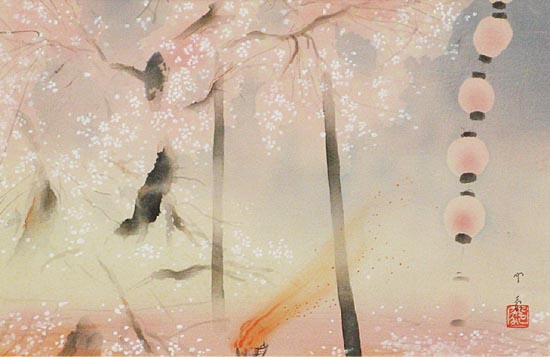
Inshou Doumoto / Cherry Blossoms at Night
Kakejiku Shop
There was a shop which sells kakejiku near the art gallery, and I went there. Some auspicious kakejiku were displayed such as red Mt. Fuji, the rising sun and cranes and turtles, because a new year is just around the corner. There was Yukihiko Nakagawa’s work at the exhibition space. I like his works, but to be honest I didn’t like this work very much. Yukihiko Nakagawa skillfully paints with an air brush, therefore he has his strong and weak points on his works and I have things I like and dislike about his works. I like red Mt. Fuji, Peonies and a water fall works by him.
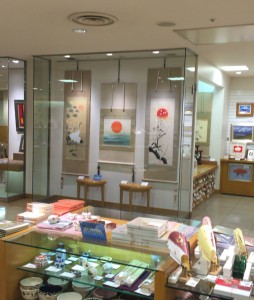
Kakejiku Shop 01
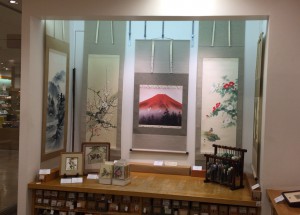
Kakejiku Shop 02
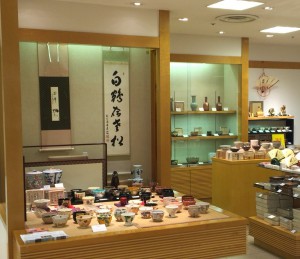
Kakejiku Shop 03
Dinner at the jacalanta Restaurant
After leaving the department store, we visited the jacalanta, my favorite restaurant. This restaurant is located near the Ikuta-jinja Shrine. I like this restaurant because it looks like a hideaway and has a calm atmosphere but the staff is very cheerful. The restaurant is very popular among girls, so I wanted to take my fiancee at least once. Today was a good opportunity. “Jacalanta omelet rice” is the most popular dish on the menu. Cheese fondue is also delicious. I drank 10 glasses of beer and felt better. My fiancee took a picture of me and Yossy (the shp manager). I and my fiancee also had our photo taken by Yossy, and then Yossy printed the picture, set it in a frame and gave it for us on the spot. This was a nice surprise and Omotenashi (Japanese hospitality). Important matters concerning Omotenashi are anticipating what guests hope, acting before they order, and surprising them. Nice Omotenashi, Yossy! It was a wonderful Christmas present.
The WESTERN HALL Bar
My fiancee can drink alcohol, so we would visit the WESTERN HALL, my favorite bar, until the last train. It is located at a busy district of Sannomiya. I was introduced this bar by my friend, and many of my friends often visit there. We also use the bar to share information. An atmosphere of the bar is so calm, so there is a tendency to think it is inaccessible. However, Kunihiko Deguchi, the bartender, is gentle and his talk is always enjoyable. There are many types of liquors. Kunihiko Deguchi is bald, but he is never a scary person. Don’t worry. The bar is an enjoyable spot for me because I can talk about various topics that range from business to private, and know about my friends’ situations.
It was time to get on the last train, so we left the bar. We were in a good mood all day. Today was a great celebration day of Christmas.

